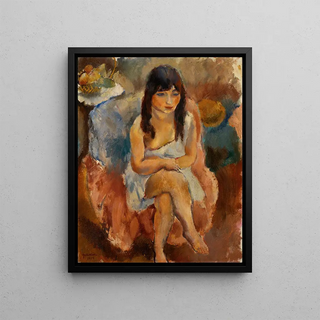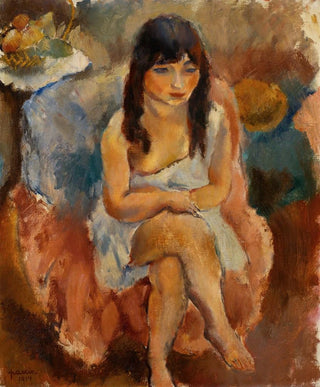Art print | Seated Figure Young girl sitting - Jules Pascin


View from behind

Frame (optional)
In the vibrant world of art, some works stand out for their ability to capture the very essence of humanity. "Seated Figure Young Girl Sitting - Jules Pascin" is one of those creations that, through its apparent simplicity, evokes deep reflection. This piece immerses us in a moment of contemplation, where the gaze of the young girl sitting seems to invite us to share a suspended moment in time. The delicacy of Pascin's features and the way he plays with light and shadow reveal a unique artistic sensitivity, transporting us to a world where every detail matters.
Style and uniqueness of the work
Jules Pascin's style is characterized by a harmonious blend of impressionism and modernism, offering a singular vision of his subjects. In "Seated Figure Young Girl Sitting," he manages to create an intimate atmosphere, where the female figure becomes the focal point of a minimalist composition. The flowing lines and soft colors blend to evoke a palpable emotion. The posture of the young girl, both relaxed and pensive, reflects an introspection that resonates with the viewer. Pascin excels in bringing to life an apparently ordinary scene, infusing it with psychological depth that encourages reflection. Every brushstroke seems to tell a story, revealing the complexity of human feelings.
The artist and his influence
Jules Pascin, born in Bulgaria and having worked in Paris, is an artist whose journey is as fascinating as his works. Influenced by the artistic movements of his time, he developed a style that is uniquely his own, blending European influences with Jewish tradition. His work is often associated with the depiction of bohemian life, capturing scenes of everyday life with a unique sensitivity. Pascin was also a mentor to many artists, sharing his knowledge and passion for art. His influence endures today, and his works continue to inspire generations of artists and art lovers. The way he approached the human figure, with such finesse and empathy, remains an essential reference in art history.
A decoration

Matte finish

View from behind

Frame (optional)
In the vibrant world of art, some works stand out for their ability to capture the very essence of humanity. "Seated Figure Young Girl Sitting - Jules Pascin" is one of those creations that, through its apparent simplicity, evokes deep reflection. This piece immerses us in a moment of contemplation, where the gaze of the young girl sitting seems to invite us to share a suspended moment in time. The delicacy of Pascin's features and the way he plays with light and shadow reveal a unique artistic sensitivity, transporting us to a world where every detail matters.
Style and uniqueness of the work
Jules Pascin's style is characterized by a harmonious blend of impressionism and modernism, offering a singular vision of his subjects. In "Seated Figure Young Girl Sitting," he manages to create an intimate atmosphere, where the female figure becomes the focal point of a minimalist composition. The flowing lines and soft colors blend to evoke a palpable emotion. The posture of the young girl, both relaxed and pensive, reflects an introspection that resonates with the viewer. Pascin excels in bringing to life an apparently ordinary scene, infusing it with psychological depth that encourages reflection. Every brushstroke seems to tell a story, revealing the complexity of human feelings.
The artist and his influence
Jules Pascin, born in Bulgaria and having worked in Paris, is an artist whose journey is as fascinating as his works. Influenced by the artistic movements of his time, he developed a style that is uniquely his own, blending European influences with Jewish tradition. His work is often associated with the depiction of bohemian life, capturing scenes of everyday life with a unique sensitivity. Pascin was also a mentor to many artists, sharing his knowledge and passion for art. His influence endures today, and his works continue to inspire generations of artists and art lovers. The way he approached the human figure, with such finesse and empathy, remains an essential reference in art history.
A decoration






